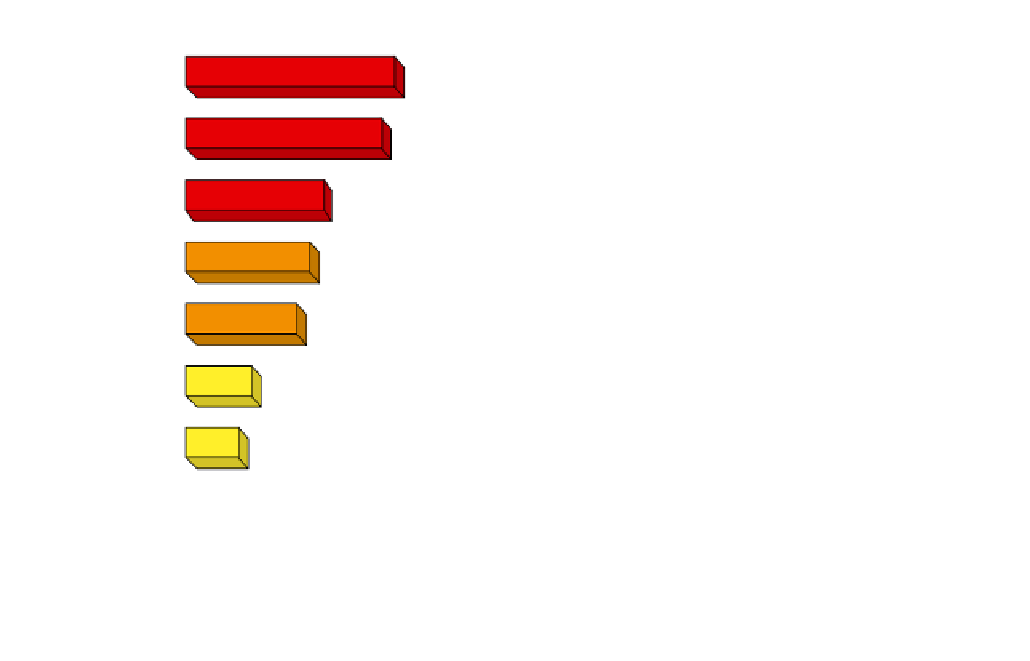Environmental Engineering Reference
In-Depth Information
A
nontransmissible disease
is not caused by living
organisms and does not spread from one person to
another. Such diseases tend to develop slowly and
have multiple causes. Examples include cardiovascu-
lar (heart and blood vessel) disorders, asthma, emphy-
sema, and malnutrition.
In an infection, a pathogen in the form of a bac-
terium, virus, or parasite invades your body and mul-
tiplies in its cells and tissues. This can lead to an
infectious
or
transmissible disease
if your body can-
not mobilize its defenses fast enough to keep the
pathogen from interfering with your bodily functions.
Pathogens or infectious agents can be spread from
one person to another by air, water, food, and body
fluids such as pathogen-loaded droplets present in the
sneezes, coughs, feces, urine, or blood of infected peo-
ple. Pathogen-containing organisms such as mosqui-
toes can spread some infectious diseases. Figure 14-3
shows the annual death toll from the world's seven
deadliest infectious diseases.
Great news.
Since 1900, and especially since 1950,
the incidences of infectious diseases and the death
rates from such diseases have been greatly reduced.
This has been achieved mostly by a combination of
better health care, the use of antibiotics to treat infec-
tious disease caused by bacteria, and the development
of vaccines to prevent the spread of some infectious vi-
ral diseases.
Bad news.
Many disease-carrying bacteria have de-
veloped genetic immunity to widely used antibiotics.
Also, many disease-transmitting species of insects such
as mosquitoes have become immune to widely used
pesticides that once helped control their populations.
Science Case Study: Growing Germ Resistance
to Antibiotics
Rapidly producing infectious bacteria can undergo
natural selection and become genetically resistant to
widely used antibiotics.
We may be falling behind in our efforts to prevent infec-
tious bacterial diseases because of the astounding re-
productive rate of bacteria, some of which can produce
16,777,216 offspring in 24 hours. Their high reproduc-
tive rate allows these organisms to become genetically
resistant to an increasing number of antibiotics through
natural selection. They can also transfer such resistance
to nonresistant bacteria.
Other factors play a key role in fostering resistance.
One is the spread of bacteria (some beneficial and some
harmful) around the globe by human travel and inter-
national trade. Another is the overuse of pesticides,
which increases populations of pesticide-resistant in-
sects and other carriers of bacterial diseases.
Yet another factor is overuse of antibiotics by doc-
tors. According to a 2000 study by Richard Wenzel and
Michael Edward, at least half of all antibiotics used to
treat humans are prescribed unnecessarily. In many
countries, antibiotics are available without a prescrip-
tion, which also promotes unnecessary use. Resistance
to some antibiotics has also increased due to their
widespread use in livestock and diary animals to con-
trol disease and to promote growth.
As a result of these factors acting together, every
major disease-causing bacterium now has strains that
resist at least one of the roughly 160 antibiotics we
use to treat bacterial infections, such as those from
tuberculosis.
Disease
(type of agent)
Deaths per year
Pneumonia and flu
(bacteria and viruses)
3.2 million
HIV/AIDS
(virus)
3.0 million
Science Case Study: The Growing Global
Threat from Tuberculosis
Tuberculosis kills 1.7 million people per year and
could kill 26 million people between 2005 and 2020.
Since 1990, one of the world's most underreported sto-
ries has been the rapid spread of tuberculosis (TB). Ac-
cording to the WHO, this highly infectious bacterial
disease strikes 9 million people per year and kills 1.7
million of them—about 84% of them in developing
countries. The WHO projects that between 2005 and
2020, 26 million people will die of this disease unless
current efforts and funding to control TB are greatly
strengthened and expanded.
Many TB-infected people do not appear to be sick.
Indeed, half of them do not know they are infected.
Several factors account for the recent increase in TB
incidence. One is the lack of TB screening and control
programs, especially in developing countries, where
Malaria
(protozoa)
2.0 million
Diarrheal diseases
(bacteria and viruses)
1.9 million
Tuberculosis
(bacteria)
1.7 million
Hepatitis B
(virus)
1 million
Measles
(virus)
800,000
Figure 14-3
Global outlook:
the World Health Organization
estimates that each year the world's seven deadliest infectious
diseases kill 1.9 million people—most of them poor people in
developing countries. This amounts to about 38,000 mostly pre-
ventable deaths every day.
Critical thinking: what three things
would you do to reduce the death toll?
(Data from The World
Health Organization)


